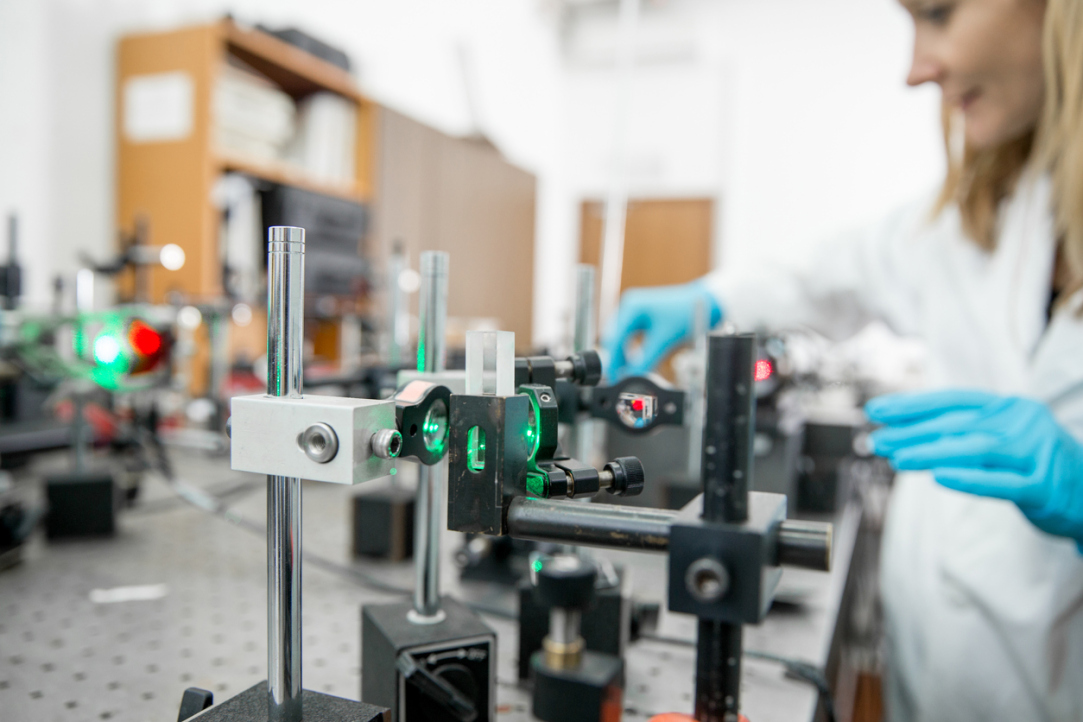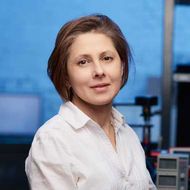Russian Scientists Integrate Microdisk Laser and Waveguide on a Single Substrate

A group of Russian scientists led by Professor Natalia Kryzhanovskaya at HSE Campus in St Petersburg has been researching microdisk lasers with an active region based on arsenide quantum dots. For the first time, researchers have successfully developed a microdisk laser coupled with an optical waveguide and a photodetector on a single substrate. This design enables the implementation of a basic photonic circuit on the same substrate as the radiation source (microlaser). In the future, this will help speed up data transfer and reduce equipment weight without compromising quality. The study results have been published in Semiconductors.
The growing demands for higher speed and larger volumes of transmitted information necessitate improvements to current communication methods. Photonic integrated circuits (PICs), which use light to transmit information, operate faster, generate less heat, are more resistant to interference, and consume less energy compared to their electronic counterparts.
However, their effective use requires efficient, compact light sources, such as gallium arsenide (GaAs) microdisk lasers. The length of a conventional Fabry–Perot laser is around 1 mm, while a microdisk laser can be up to 1,000 times smaller. In this study, the laser size was reduced to a diameter of 30 to 40 microns.
Effective directional radiation output is essential for the successful implementation of optical communication in photonic integrated circuits (PICs). Directional radiation can be achieved by optically coupling microlasers with a nearby waveguide. The authors of the paper designed and fabricated both a microlaser and a waveguide from a single epitaxial structure, resulting in reduced size and increased stability.
'Creating microdisk lasers coupled to a waveguide is a challenging task. This process involves developing a thin-film epitaxial structure with a specific composition. In our case, we employed gas-phase epitaxy of metal-organic compounds, a method for layered formation of crystals of different substances on top of one another. Lasers and waveguides were created from the resulting structure. This was made possible thanks to the innovations developed by the Mokerov Institute of Ultra High Frequency Semiconductor Electronics of the Russian Academy of Sciences. All these processes required the use of advanced technology and the efforts of a team of experienced, talented, and qualified specialists,' according to Nikita Fominykh, Junior Research Fellow of the International Laboratory of Quantum Optoelectronics at HSE Campus in St Petersburg.
In addition to radiation sources, radiation receivers are also essential for the operation of PICs. In this work, waveguide photodetectors fulfil this role. Thus, it becomes possible to create an optocoupler that combines a microlaser and a waveguide photodetector with a matching operating wavelength on a single substrate. The photodetector used in the optocoupler measured no more than 90 microns, enabling the creation of a highly compact and energy-efficient optocoupler.
'Microdisk lasers are unique optoelectronic devices. With a size comparable to the diameter of a spider silk thread, they can generate a significant amount of optical power. We have experimentally demonstrated that all optoelectronic components necessary for a photonic integrated circuit—a microdisk laser, a waveguide, and a photodetector—can be fabricated from a single epitaxial heterostructure on the same substrate,' says co-author of the paper Natalia Kryzhanovskaya, Head of the International Laboratory of Quantum Optoelectronics at HSE Campus in St Petersburg.
See also:
Machine Learning Links Two New Genes to Ischemic Stroke
A team of scientists from HSE University and the Kurchatov Institute used machine learning methods to investigate genetic predisposition to stroke. Their analysis of the genomes of over 5,000 people identified 131 genes linked to the risk of ischemic stroke. For two of these genes, the association was found for the first time. The paper has been published in PeerJ Computer Science.
First Digital Adult Reading Test Available on RuStore
HSE University's Centre for Language and Brain has developed the first standardised tool for assessing Russian reading skills in adults—the LexiMetr-A test. The test is now available digitally on the RuStore platform. This application allows for a quick and effective diagnosis of reading disorders, including dyslexia, in people aged 18 and older.
Low-Carbon Exports Reduce CO2 Emissions
Researchers at the HSE Faculty of Economic Sciences and the Federal Research Centre of Coal and Coal Chemistry have found that exporting low-carbon goods contributes to a better environment in Russian regions and helps them reduce greenhouse gas emissions. The study results have been published in R-Economy.
Russian Scientists Assess Dangers of Internal Waves During Underwater Volcanic Eruptions
Mathematicians at HSE University in Nizhny Novgorod and the A.V. Gaponov-Grekhov Institute of Applied Physics of the Russian Academy of Sciences studied internal waves generated in the ocean after the explosive eruption of an underwater volcano. The researchers calculated how the waves vary depending on ocean depth and the radius of the explosion source. It turns out that the strongest wave in the first group does not arrive immediately, but after a significant delay. This data can help predict the consequences of eruptions and enable advance preparation for potential threats. The article has been published in Natural Hazards. The research was carried out with support from the Russian Science Foundation (link in Russian).
Centre for Language and Brain Begins Cooperation with Academy of Sciences of Sakha Republic
HSE University's Centre for Language and Brain and the Academy of Sciences of the Republic of Sakha (Yakutia) have signed a partnership agreement, opening up new opportunities for research on the region's understudied languages and bilingualism. Thanks to modern methods, such as eye tracking and neuroimaging, scientists will be able to answer questions about how bilingualism works at the brain level.
How the Brain Responds to Prices: Scientists Discover Neural Marker for Price Perception
Russian scientists have discovered how the brain makes purchasing decisions. Using electroencephalography (EEG) and magnetoencephalography (MEG), researchers found that the brain responds almost instantly when a product's price deviates from expectations. This response engages brain regions involved in evaluating rewards and learning from past decisions. Thus, perceiving a product's value is not merely a conscious choice but also a function of automatic cognitive mechanisms. The results have been published in Frontiers in Human Neuroscience.
AI Predicts Behaviour of Quantum Systems
Scientists from HSE University, in collaboration with researchers from the University of Southern California, have developed an algorithm that rapidly and accurately predicts the behaviour of quantum systems, from quantum computers to solar panels. This methodology enabled the simulation of processes in the MoS₂ semiconductor and revealed that the movement of charged particles is influenced not only by the number of defects but also by their location. These defects can either slow down or accelerate charge transport, leading to effects that were previously difficult to account for with standard methods. The study has been published in Proceedings of the National Academy of Sciences (PNAS).
Electrical Brain Stimulation Helps Memorise New Words
A team of researchers at HSE University, in collaboration with scientists from Russian and foreign universities, has investigated the impact of electrical brain stimulation on learning new words. The experiment shows that direct current stimulation of language centres—Broca's and Wernicke's areas—can improve and speed up the memorisation of new words. The findings have been published in Neurobiology of Learning and Memory.
Artificial Intelligence Improves Risk Prediction of Complex Diseases
Neural network models developed at the HSE AI Research Centre have significantly improved the prediction of risks for obesity, type 1 diabetes, psoriasis, and other complex diseases. A joint study with Genotek Ltd showed that deep learning algorithms outperform traditional methods, particularly in cases involving complex gene interactions (epistasis). The findings have been published in Frontiers in Medicine.
Cerium Glows Yellow: Chemists Discover How to Control Luminescence of Rare Earth Elements
Researchers at HSE University and the Institute of Petrochemical Synthesis of the Russian Academy of Sciences have discovered a way to control both the colour and brightness of the glow emitted by rare earth elements. Their luminescence is generally predictable—for example, cerium typically emits light in the ultraviolet range. However, the scientists have demonstrated that this can be altered. They created a chemical environment in which a cerium ion began to emit a yellow glow. The findings could contribute to the development of new light sources, displays, and lasers. The study has been published in Optical Materials.




